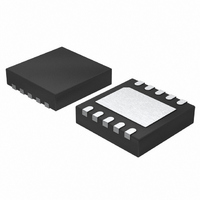MCP635T-E/MF Microchip Technology, MCP635T-E/MF Datasheet - Page 24

MCP635T-E/MF
Manufacturer Part Number
MCP635T-E/MF
Description
Dual, 24MHz OP W /CS, E Temp 10 DFN 3x3mm T/R
Manufacturer
Microchip Technology
Datasheet
1.MCP631-ESN.pdf
(42 pages)
Specifications of MCP635T-E/MF
Amplifier Type
General Purpose
Number Of Circuits
2
Output Type
Rail-to-Rail
Slew Rate
10 V/µs
Gain Bandwidth Product
24MHz
Current - Input Bias
4pA
Voltage - Input Offset
1800µV
Current - Supply
2.5mA
Current - Output / Channel
70mA
Voltage - Supply, Single/dual (±)
2.5 V ~ 5.5 V
Operating Temperature
-40°C ~ 125°C
Mounting Type
Surface Mount
Package / Case
10-DFN
Number Of Channels
2
Voltage Gain Db
124 dB
Common Mode Rejection Ratio (min)
63 dB
Input Offset Voltage
8 mV
Operating Supply Voltage
3 V, 5 V
Maximum Operating Temperature
+ 125 C
Mounting Style
SMD/SMT
Minimum Operating Temperature
- 40 C
Lead Free Status / RoHS Status
Lead free / RoHS Compliant
-3db Bandwidth
-
Lead Free Status / Rohs Status
Details
Available stocks
Company
Part Number
Manufacturer
Quantity
Price
Company:
Part Number:
MCP635T-E/MF
Manufacturer:
MICROCHIP
Quantity:
12 000
MCP631/2/3/5
C
at V
The largest value of R
on noise gain (see G
Loads”), C
Figure 4-9
several C
these values to reduce either output loading or gain
peaking (step response overshoot).
FIGURE 4-9:
R
Figure 2-34
large signal step responses at G = +1 V/V. The unity
gain buffer usually has R
Figure 2-36
large signal step responses at G = -1 V/V. Since the
noise gain is 2 V/V and C
chosen to be R
It is also possible to add a capacitor (C
R
This makes it possible to use larger values of R
conditions for stability are summarized in
EQUATION 4-6:
DS22197A-page 24
N
F
F
Given:
We need:
and R
vs. Gain.
to compensate for the de-stabilizing effect of C
P
1.E+05
1.E+04
1.E+03
1.E+02
. This filter has a single real pole at 1/(2πR
G
G
f
f
F
F
100k
N1
N2
f
f
10k
100
≤
≤
F
Z
1k
f
f
N
G
GBWP
GBWP
=
=
=
=
shows the maximum recommended R
1
form a low-pass filter that affects the signal
G
and
and
C
C
values. Some applications may modify
f
1
1
1
C
C
G
G
F
C
G
G
and the open-loop gain’s phase shift.
= 100 pF
= 320 pF
+
+
⁄
(
F
G
= 10 pF
= 32 pF
(
G
⁄
⁄
= 1 nF
Figure 2-35
Figure 2-37
2
= R
R
C
(
(
N1
π
2G
4G
F
G
R
⁄
⁄
⁄
G
F
R
N2
N1
C
G
C
N
G
Noise Gain; G
Maximum Recommended
= 1 kΩ and R
F
F
N2
)
)
F
, G
, G
in Section 4.3.1 “Capacitive
that should be used depends
F
)
)
G
= 0Ω and R
≈ 10 pF, the resistors were
N1
N1
show the small signal and
show the small signal and
10
<
>
G
G
N
N2
N2
N
(V/V)
= 500Ω.
F
G
) in parallel with
open.
Equation
G
N
> +1 V/V
N
F
C
. The
100
F
N
4-6.
).
for
G
.
4.4
The MCP633 is a single amplifier with Chip Select
(CS). When CS is pulled high, the supply current drops
to 1 µA (typical) and flows through the CS pin to V
When this happens, the amplifier output is put into a
high-impedance state. By pulling CS low, the amplifier
is enabled. The CS pin has an internal 5 MΩ (typical)
pulldown resistor connected to V
the CS pin is left floating.
Figure 2-43
response to a CS pulse.
The MCP635 is a dual amplifier with two CS pins; CS
controls op amp A and CS
op amps are controlled independently, with an enabled
quiescent current (I
a disabled I
the supply pins is the sum of the two op amps’ I
typical value for the MCP635’s I
or 5 mA when there are 0, 1 or 2 amplifiers enabled,
respectively.
4.5
With this family of operational amplifiers, the power
supply pin (V
bypass capacitor (i.e., 0.01 µF to 0.1 µF) within 2 mm
for good high frequency performance. Surface mount,
multilayer ceramic capacitors, or their equivalent,
should be used.
These op amps require a bulk capacitor (i.e., 2.2 µF or
larger) within 50 mm to provide large, slow currents.
Tantalum capacitors, or their equivalent, may be a good
choice. This bulk capacitor can be shared with other
nearby analog parts as long as crosstalk through the
supplies does not prove to be a problem.
4.6
These op amps are fast enough that a little extra care
in the PCB (Printed Circuit Board) layout can make a
significant difference in performance. Good PC board
layout
performance shown in the specifications and Typical
Performance Curves; it will also help you minimize
EMC (Electro-Magnetic Compatibility) issues.
Use a solid ground plane. Connect the bypass local
capacitor(s) to this plane with minimal length traces.
This cuts down inductive and capacitive crosstalk.
Separate digital from analog, low speed from high
speed, and low power from high power. This will reduce
interference.
Keep sensitive traces short and straight. Separate
them from interfering components and traces. This is
especially important for high frequency (low rise time)
signals.
techniques
MCP633 and MCP635 Chip Select
Power Supply
High Speed PCB Layout
Q
show the output voltage and supply current
DD
of 1 µA/amplifier (typical). The I
for single supply) should have a local
Q
) of 2.5 mA/amplifier (typical) and
will
© 2009 Microchip Technology Inc.
Figure
B
help
controls op amp B. These
Q
SS
1-1,
will be 2 µA, 2.5 mA
you
, so it will go low if
Figure 2-42
achieve
Q
seen at
Q
; the
and
SS
the
A
.













